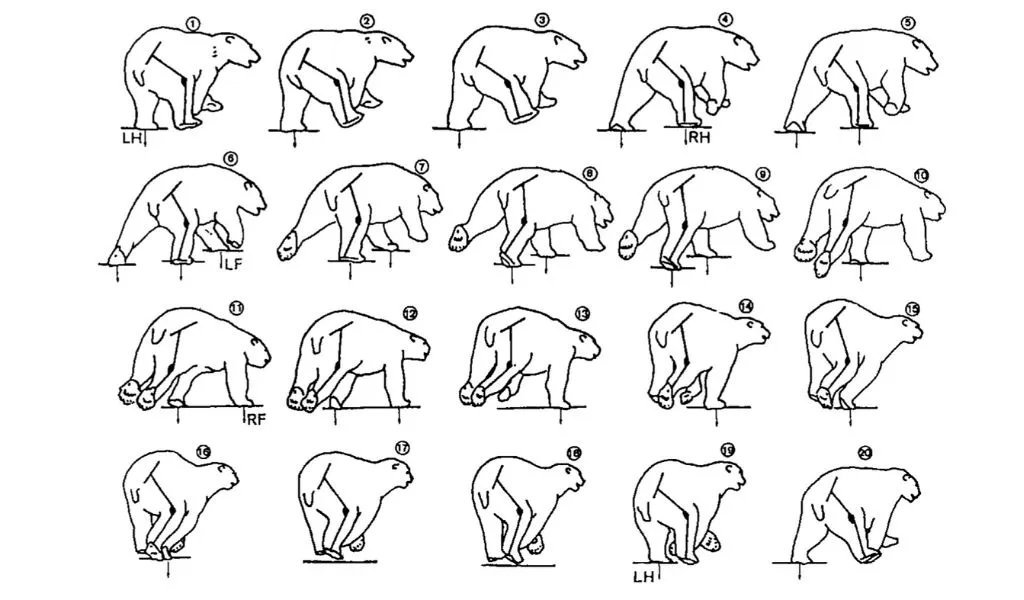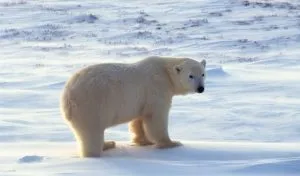Polar bears (ursus maritimus) are the largest of the bear family and carry a fair amount of weight. But don’t let this fool you into thinking these mammals can’t take it up a gear when needed because they sure can. So, just how fast are polar bears?
Polar bears can run up to 40 km/h (25 mph), although they can quickly overheat when they do too much physical activity so you will usually find them moving slowly at around 5.5 km/h (3.4 mph). They are also great swimmers, reaching speeds up to 10 km/h (6 mph) in the water.
Keep reading to find out more about the way polar bears run, walk, and swim. Plus, some interesting facts about how they have evolved to stay steady on the ice when moving.
How Fast Are Polar Bears
When sprinting, polar bears can reach speeds up to 40 km/h (25 mph) although they will only do this when chasing prey or protecting their young, their normal walking speed is more like 5.6 km/h (3.5 mph)1 (source: Seaworld).
Being such large and heavy animals, running consumes a lot of energy at any given speed compared to other mammals so they try not to do this too often. When they overheat, they will dive in the water to cool off.
Instead, they are ‘sit and wait’ hunters2 (source: University of California via Science Daily) and can usually be found wandering slowly across the ice.
Much like other bears, polar bears can walk on their 2 hind legs for short periods of time but usually walk and run with all 4 legs.
How Do Polar Bears Move On Ice
Polar bears can move well on the ice where they spend their winter thanks to a well-balanced gait as they walk and paws with a rough underside and short claws that provide friction on the ice.
The gait of an animal is how its limbs move as it walks.
Brown bears move the two left legs and the two right legs in tandem3 (source: Sciencing). However, polar bears have a different gait that helps them move on the ice. They move each leg individually and walk with a sway in their hips and head.
Scientists think this is how polar bears are able to stay well balanced on the icy surfaces they inhabit4 (source: Netherlands Journal of Zoology, S. Renous, J. Gasc, and A. Abourachid, Vol 48, No. 2, 1997).
This image from the study shows you how polar bears move, you’ll notice they also extend their hind legs much further than other bears:

Polar bear paws are also well adapted to the environment. The huge size distributes their weight across the surface5 (source: BBC), this is essential because an average adult male polar bear can weigh up to 680kg (1500lbs)6 (source: The Polar Bear, A. Hemstock, 1999).
To stay steady on the ice, their paws are as rough as sandpaper on the bottom and their short claws help them keep traction on the surface7 (source: Polar Bears: A Complete Guide to Their Biology and Behavior, A. E. Derocher, 2012).
Overgrown hair on their paws also helps create friction as well as keeping them warm.
These are not the only adaptations that help polar bears survive in the arctic. They also have two layers of fur and plenty of blubber for insulation, short ears and tail to minimize heat loss, and a long head and neck to reach seals through holes in the ice.
How Far Do Polar Bears Travel
The home range of an animal is the area it regularly travels in search of food or mates. The home range of polar bears is much larger than terrestrial mammals because the sea ice they inhabit during winter is moving.
The speed at which the sea ice is moving can have a big impact on the home range of the polar bear so it will vary between regions. Reliable estimates suggest their home range is about 125,100 km28 (source: Ecology Letters, S. Ferguson, Vol 2, No. 5, 2002).
In a typical day, a polar bear can walk 30 km (19 mi.) and can do so for several days in a row.
Using GPS trackers, one polar bear was tracked walking 80 km (50 mi.) in a 24 hour period and another traveled 1,119 km (695 mi.) in one year9 (source: WWF).
They are very good at swimming for long distances too, this is required to move from the melting sea ice to the mainland or islands for the summer.
The furthest recorded swim by a polar bear lasted over 9 days and totaled 687km in distance10 (source: Canadian Journal of Zoology, A. M. Pagano, Vol 90, No. 5, 2012).
Related Questions
Can You Outrun a Polar Bear?
No, the typical human cannot outrun a polar bear as the average sprinting speed for a human is 24km\h (15mph)11 (source: Trackspikes) whereas a polar bear can sprint at 40 km/h (25 mph). Even the world’s fastest human, Usain Bolt, with his 37.5km/h sprint couldn’t outrun an average polar bear12 (source: Olympics).
Luckily, polar bears do not hunt humans so you shouldn’t need to run from one. But even if you do come across one, it’s not advisable to run as this will activate its natural instincts to chase.
Is a Grizzly Bear Faster Than a Polar Bear?
Yes, grizzly bears are faster than polar bears with a top recorded speed of 48 km/h (30 mph)13 (source: United States Department Of The Interior National Park Service, 1937) which is faster than a polar bear’s top speed of 40 km/h (25 mph). This is because grizzly bears are, on average, smaller in mass than polar bears.
How Fast Are Polar Bears in Water?
As well as their ability to stay steady whilst moving on the ice, another evolved trait is that polar bears can swim extremely well.
They have hollow fur which contains air to keep them buoyant along with lots of blubber. They also have slightly webbed paws that help in the water. They can reach speeds up to 6mph in water14 (source: WWF).


![You are currently viewing How Fast Are Polar Bears on Land and Underwater? [Surprisingly Quick!]](https://polarguidebook.com/wp-content/uploads/2021/08/How-Fast-are-Polar-Bears.jpg)
![Read more about the article Can Polar Bears Climb Trees? [No – Here’s Why]](https://polarguidebook.com/wp-content/uploads/2021/09/Can-Polar-Bears-Climb-Trees-300x176.jpg)

